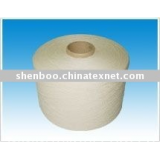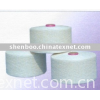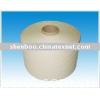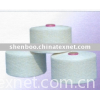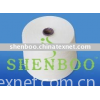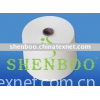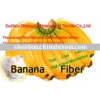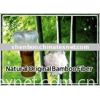| Ramie (pronounced Ray-me) is one of the oldest vegetable fibers and has been used for thousands of years. It was used in mummy cloths in Egypt during the period 5000 - 3000 BC, and has been grown in China for many centuries.
Ramie (Boehmeria nivea), commonly known as China grass, white ramie, green ramie and rhea, is one of the group referred to as the bast fiber crops. The ramie plant is a hardy perennial belonging to the Urticaceae or Nettle family, which can be harvested up to 6 times a year. It produces a large number of unbranched stems from underground rhizomes and has a crop life from 6 to 20 years. The fibres need chemical treatment to remove the gums and pectins found in the bark. |
The process of transforming the ramie fibres into fabric is similar to the process used for manufacturing linen from flax. The true ramie or 'China Grass' is also known as 'white ramie' and is the Chinese cultivated plant. It has large heart shaped, crenate leaves covered on the underside with white hairs that give it a silvery appearance. Boehmeria nivea var. tenacissima, is believed to have originated in the Malay Peninusula and is known as 'green ramie' or 'rhea'. Green ramie has smaller leaves than true ramie and is better suited to tropical climates.
The fibre is very fine like silk, and being naturally white in colour does not need bleaching.
Long before cotton was introduced in the Far East, it was used for Chinese burial shrouds over 2,000 years ago. Ramie's popularity increased in the mid 1980s with a fashion emphasis on natural fibres.
Chemically ramie is classified as a cellulose fibre, just as cotton, linen, and rayon. The leading global producers of ramie are China, Taiwan, Korea, the Philippines and Brazil. Ramie is often blended with cotton to make woven and knit fabrics that resemble fine linen to coarse canvas. Ramie is commonly used in clothing, tablecloths, napkins and handkerchiefs. It is often blended with cotton in knit sweaters. Outside the clothing industry, ramie is used in fish nets, canvas, upholstery fabrics, straw hats and fire hoses.
Within the clothing and textile industry ramie has the following advantages and disadvantages:
Advantages of Ramie
Resistant to bacteria, mildew, alkalis, rotting, light and insect attack.
Extremely absorbent (this makes it comfortable to wear)
Dyes fairly easy.
Natural stain resistance.
Increases in strength when wet.
Withstands high water temperatures during laundering.
Smooth lustrous appearance improves with washing.
Keeps its shape and does not shrink.
Strong and durable (It is reported to have a tensile strength eight times that of cotton and seven times greater than silk).
Can be bleached.
Disadvantages of Ramie
Low in elasticity.
Lacks resiliency.
Low abrasion resistance.
Wrinkles easily.
Stiff and brittle.
Necessary de-gumming process.
High cost (due to high labour requirement in production, harvesting and decortication.)
The main producers of ramie today are China, Brazil, Philippines, India, South Korea and Thailand. Only a small percentage of the ramie produced is available on the international market. Japan, Germany, France and the UK are the main importers, the remaining supply is used domestically (in the country in which it is produced).
Ramie as a Blend
Ramie is most often blended (common is 55% ramie/45% cotton) with other fibres for its unique strength and absorbency, lustre and dye-affinity. For example,
Blended with cotton, results in increased lustre, strength and colour.
Blended with wool, results in lightness and minimises shrinkage.
Blended with rayon, results in higher wet strength
|
|
